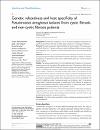Genetic relatedness and host specificity of Pseudomonas aeruginosa isolates from cystic fibrosis and non-cystic fibrosis patients
| Author | Abdulwahab, Atqah |
| Author | Taj-Aldeen, Saad J. |
| Author | Doiphode, S |
| Author | Abdulla, Shaikha H. |
| Author | Muhammed, Ramees |
| Author | Ahmed, Irshad |
| Author | Abdeen, Yasmine |
| Author | Sadek, Omnia |
| Author | Abu-Madi, Marawan |
| Available date | 2015-11-09T10:29:33Z |
| Publication Date | 2014-11-20 |
| Publication Name | Infection and Drug Resistance |
| Citation | AbdulWahab, A., Taj-Aldeen, S. J., Ibrahim, E., Abdulla, S. H., Muhammed, R., Ahmed, I., Abdeen, Y., Sadek, O., Abu-Madi, M. (2014).Genetic relatedness and host specificity of Pseudomonas aeruginosa isolates from cystic fibrosis and non-cystic fibrosis patients. Infection and Drug Resistance, 7 : 309 - 316 |
| ISSN | 1178-6973 |
| Abstract | Background: Pseudomonas aeruginosa is one of the primary pathogens isolated more frequently in cystic fibrosis (CF) and it exhibits innate resistance to a wide range of antibiotics. Purpose: We sought to determine whether the highly prevalent genotypes of P. aeruginosa are specifically linked to CF patients and have any related multidrug antibiotic resistance. Isolates from hospitalized non-CF patients and from environmental sources were also genotypically analyzed. Methods: Collections of P. aeruginosa from lower respiratory secretions (n=45) were genotyped using pulsed-field gel electrophoresis (PFGE). Phenotypic screening for antibiotic susceptibility was performed for the common antimicrobial agents by E-test and automated Phoenix method. Results: P. aeruginosa isolates from CF (n=32), hospitalized non-CF patients (n=13), and environment sources (n=5) were analyzed. The population structure of P. aeruginosa is highly diverse and population-specific. All PFGE results of P. aeruginosa isolates fall among four major clusters. Cluster 1 contained 16 P. aeruginosa isolates from CF patients and two from environmental sources; cluster 2 contained 11 P. aeruginosa isolates from CF and one each from non-CF and environmental sources; cluster 3 contained 12 P. aeruginosa isolates from hospitalized non-CF patients and two P. aeruginosa isolates from one CF patient and one environmental source; and cluster 4 consisted of three isolates from CF patients and one from the environment. The majority of multidrug-resistant P. aeruginosa isolates were in clusters 3 and 4. P. aeruginosa isolates from CF patients were resistant to ciprofloxacin (34.4%) followed by resistance to amikacin and gentamicin (each 28%), whereas the majority of isolates from non-CF patients were resistant to meropenem (69%) and were grouped in cluster 3. Conclusion: PFGE of P. aeruginosa isolates from CF patients shows a high degree of similarity, suggesting specific adaptation of these clones to CF-affected lungs. The hospitalized non-CF cluster has a different clonal origin, indicating specific clustering in a specific location, suggesting hospital-acquired P. aeruginosa infections. |
| Sponsor | The Qatar National Research Fund (UREP 14-026-3-010). |
| Language | en |
| Publisher | Dove Medical Press Limited |
| Subject | cystic fibrosis drug susceptibility testing Pseudomonas aeruginosa pulsed-field gel electrophoresis |
| Type | Article |
| Pagination | 309 - 316 |
| Volume Number | 7 |
Files in this item
This item appears in the following Collection(s)
-
Biomedical Research Center Research [840 items ]
-
Health Sciences-CAS (pre 2016) [151 items ]


